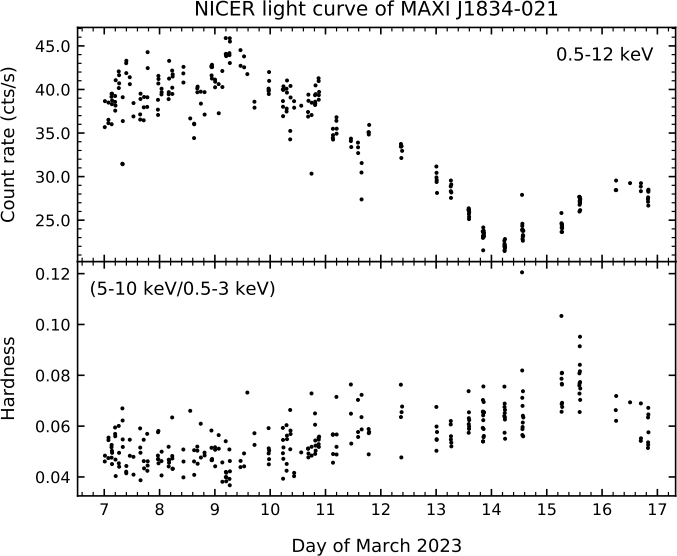NICER / ISS Science Nugget
for March 23, 2023
With a Swift assist, MAXI and NICER uncover a new candidate black-hole
On March 6, JAXA's MAXI payload team reported the detection of rising X-ray emission from the inner Galaxy, on a sightline that did not contain any previously known bright or transient sources of X-rays. Within half a day, the X-Ray Telescope (XRT) onboard NASA's Swift observatory provided images of the MAXI sky-position uncertainty ellipse, tiling the region with seven pointings and localizing the emitter to sufficient precision to enable follow-up at other wavelengths. NICER began observing the newly christened MAXI J1834-021 shortly after midnight on March 7.
Experience has shown that the majority of our Galaxy's X-ray transients are binary systems in which matter is flowing from a star onto a strongly gravitating "compact" object - a black hole, neutron star, or white dwarf - in a process called accretion. Often, the flow forms a disk around the accreting object, and the infalling material is heated to temperatures at which ionization and X-ray emission occur. But identifying the nature of the accreting body can be tricky. Some telltale signatures are well known: rapid pulsations or the occurrence of thermonuclear (Type I) bursts are invariably associated with the presence of a neutron star. Slower pulsations and the presence of a low-temperature thermal X-ray "glow" can usually be attributed to emission from the surface of a white dwarf. Other signs, especially those arising from the accretion process itself, which can be common to all three types of accretor, are more ambiguous. One such behavior is a trend in which higher-energy photons dominate when the overall emission is faint, while lower-energy photons dominate when the emission is brighter; NICER finds that MAXI J1834 exhibits this "softer when brighter" trend, and detailed spectral modeling is consistent with emission components arising from a hot disk as well as ionized plasma. A final observable characteristic that can help distinguish the nature of the X-ray source is a still-mysterious phenomenon known as quasi-periodic oscillations. QPOs from X-ray binary systems can range in frequency from fractions of a cycle per second (Hertz, or Hz) to several thousand Hz, where the highest frequencies have been seen in neutron-star systems while those in the few-Hz range appear to be common among black-hole binaries. The NICER data for MAXI J1834 reveal QPOs in the range 1.1 to 2.2 Hz, varying in a way that also appears to be correlated with overall brightness (even though just 10%, approximately, of the total emission takes part in this oscillatory behavior). Taken together, the existing evidence suggests that MAXI J1834 is a distant, newly discovered, black-hole binary. NICER's preliminary analysis of ongoing observations of MAXI J1834 was reported by J. Homan and collaborators through Astronomer's Telegram #15951.

Figure:
NICER observations track the brightness and spectral content of the black-hole candidate MAXI J1834-021 over 10 days. The upper panel shows the rate of photon detections across much of the energy band (0.5-12 keV photon energies) to which NICER is sensitive. The lower panel charts the ratio of photon counts in a high-energy band relative to those in a lower-energy band, indicating that "harder" photons are more numerous during times when the emission is fainter. Such a trend is commonly seen in accreting binary systems.
<< Previous
Main Index
Next >>